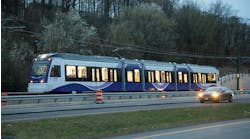On Sept. 21, Caltrain launched its new electrified schedule, bringing the 160-year-old San Francisco-San Jose, Calif., rail corridor from diesel power to electric. Caltrain says it is currently running 100 percent renewable, zero-emission service from San Francisco to San Jose for the first time.
The new high-performance electric trains offer a better experience for Caltrain riders. Caltrain service is now faster and more frequent, with 16 stations receiving trains every 15 to 20 minutes during peak hours, weekend trains arriving twice hourly and express service from San Francisco to San Jose in under an hour. Additionally, the new vehicles offer enhanced amenities, including free Wi-Fi, onboard digital displays, power outlets at each forward-facing seat, energy-efficient lighting, baby-changing tables in the bathroom, security cameras, an improved climate control system and expanded storage under the cantilevered seats. The electric trains also generate less noise than their diesel equivalent, making the trip more enjoyable both for riders and residents that live near Caltrain tracks.
Caltrain’s Electrification Project is fully funded due to the efforts of federal, state and local partners that helped secure funding.
“The electrification of Caltrain is a milestone that we have been working towards for decades and now everyone we serve can enjoy world class rail travel. I am grateful for the thousands of men and women who have worked hard to make this day a reality,” said Caltrain Executive Director Michelle Bouchard. “The future of Caltrain has arrived and I invite everyone to get on board the premier mode of transportation from San Francisco to San Jose.”
“One hundred sixty years ago, trains first made the run from San Francisco to San Jose and today, they are again the best way to travel along the Peninsula,” said Caltrain Board Chair Dev Davis. “Now everyone across the three counties we serve has access to a fast, frequent, sustainable, quiet, comfortable, Wi-Fi-enabled form of transit for the first time.”
Caltrain notes electrification will help meet ambitious regional and state climate action goals by lowering greenhouse gas emissions, improving air quality and relieving traffic congestion. Additionally, electrified service will advance equity along the corridor by reducing noise and air pollution while increasing access for equity priority communities. It will also set the framework for California’s future High Speed Rail network.
Each trainset will have seven cars, as opposed to the current five to six. Caltrain says the new trains accelerate and decelerate faster than the diesel fleet, allowing more frequent stops in the same amount of time. Diesel trains may still be occasionally utilized along the corridor in certain circumstances, such as a maintenance issue or emergency situation.
Caltrain notes riders taking the South County Connector from stations south of Tamien can save up to 20 minutes thanks to the new schedule. South County riders will ride on the diesel trains to San Jose Diridon Station, where they will find a three-minute cross-platform transfer to one of the new electric trains. In the event of a late-arriving train, connecting trains will be held at San Jose Diridon between two to five minutes to accommodate South County passengers, with the final South County Connector of the evening holding as late as needed to ensure no passenger is left behind.
Caltrain eventually plans to replace the transfer by introducing battery-equipped electric trains into service that would run on overhead power in the electrified service areas and then use battery charge to travel “off-wire” on non-electrified track areas, leading to fully zero-emission South County service.
The trains were built by Stadler US at their facility in Salt Lake City, Utah. After they were assembled, they were sent to a test facility in Pueblo, Colo., where they were tested at high speeds under numerous conditions as required by the Federal Railroad Administration. The trains were tested for braking, propulsion, ride quality, noise and vibration, door operation, Positive Train Control and Electromagnetic Interference over eight months and were then tested more than one thousand miles of travel before being certified for passenger service. The trains first began service in August of this year.






